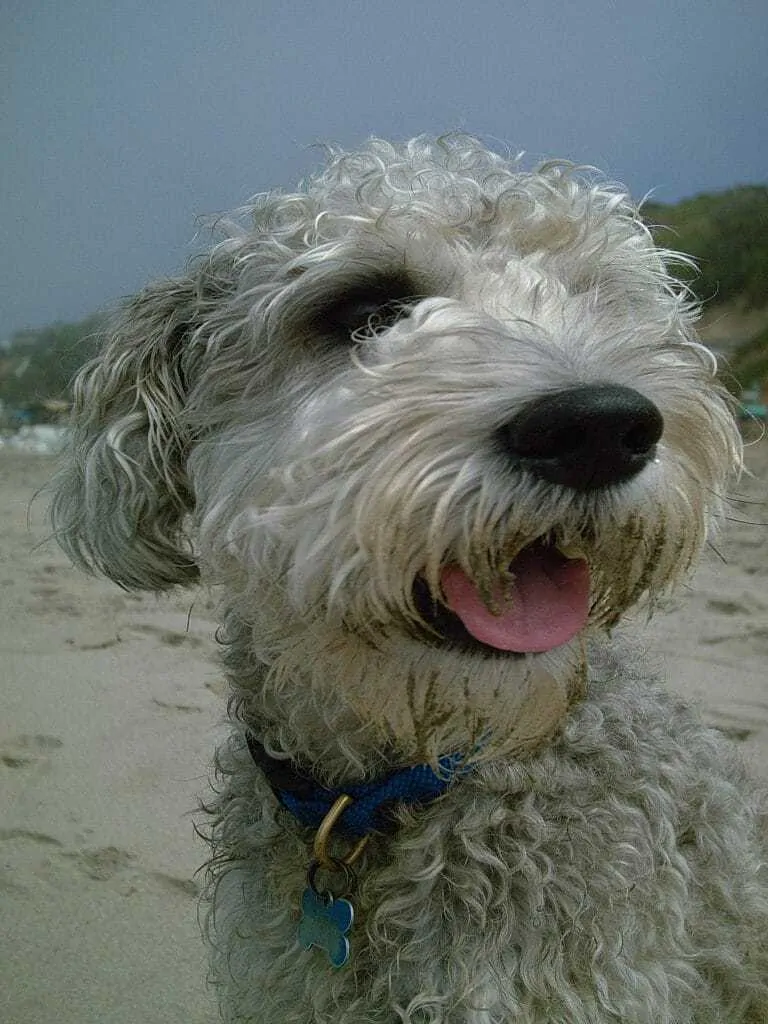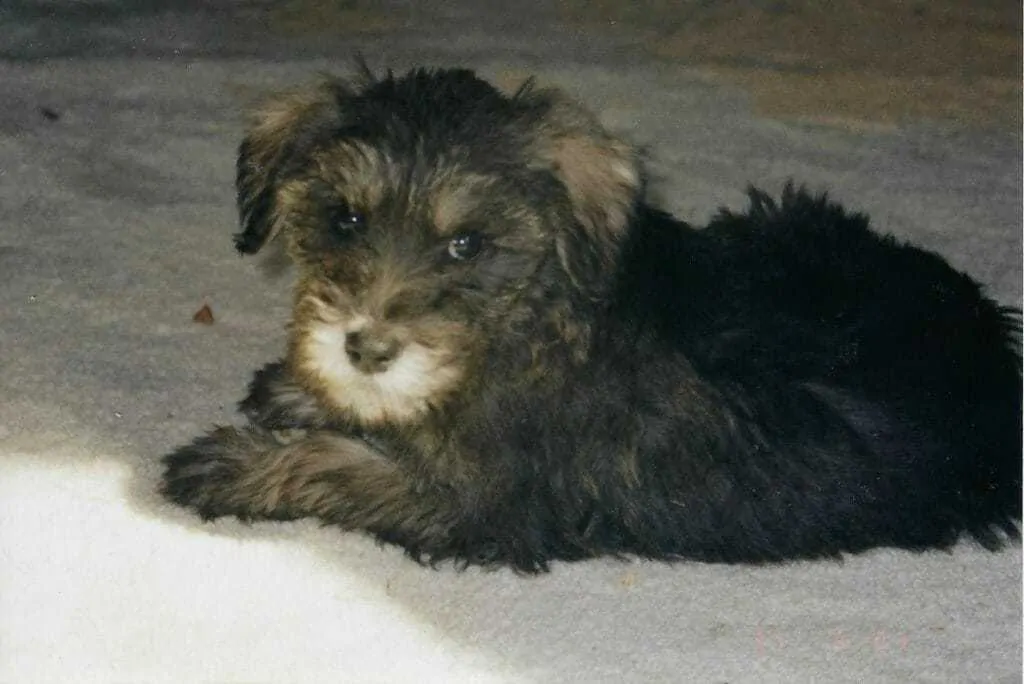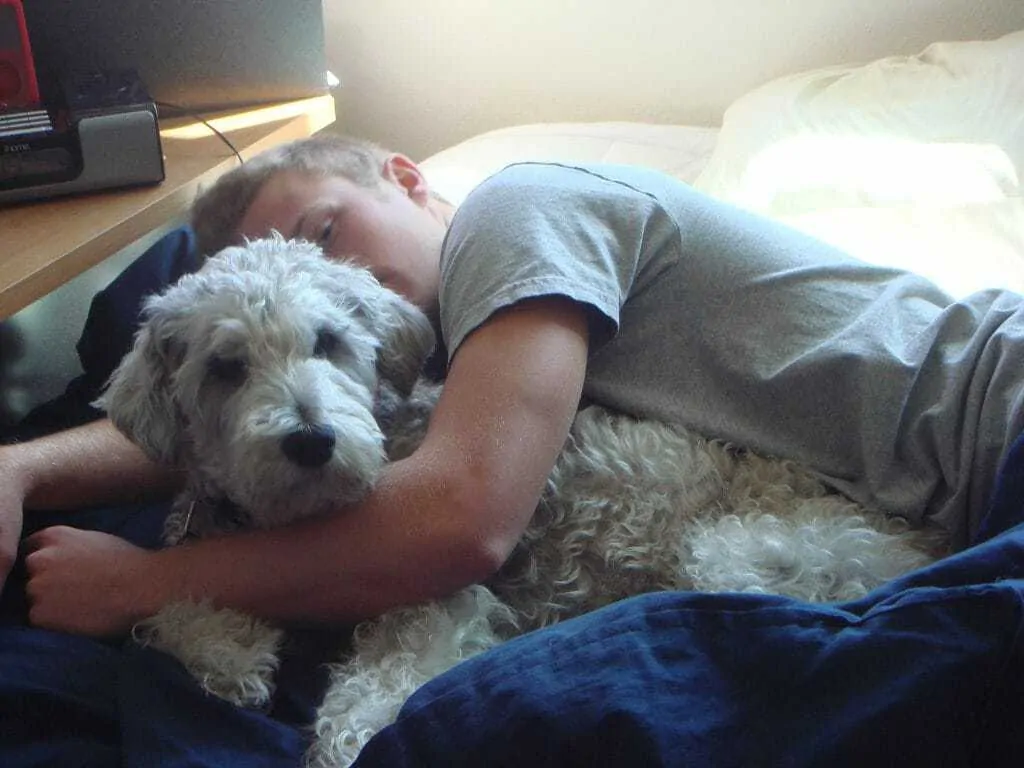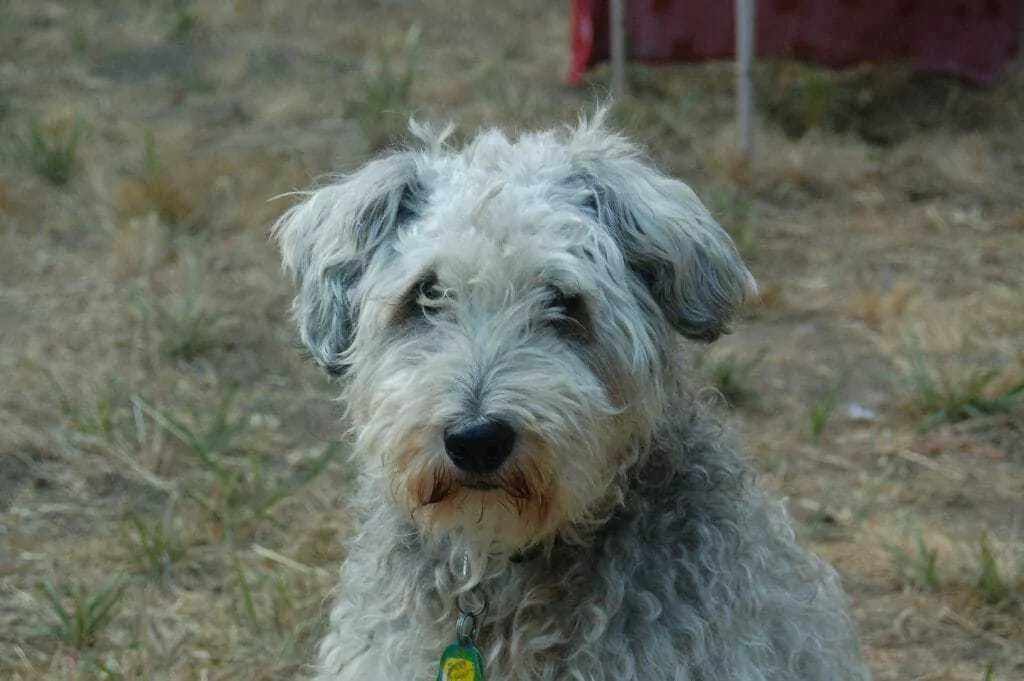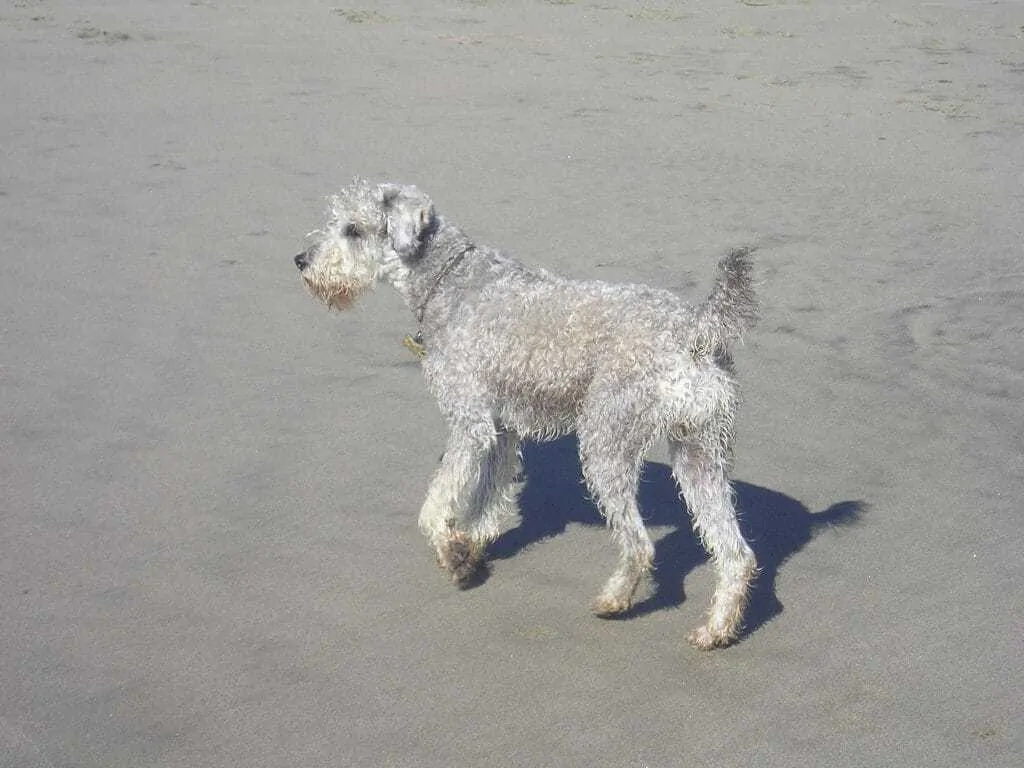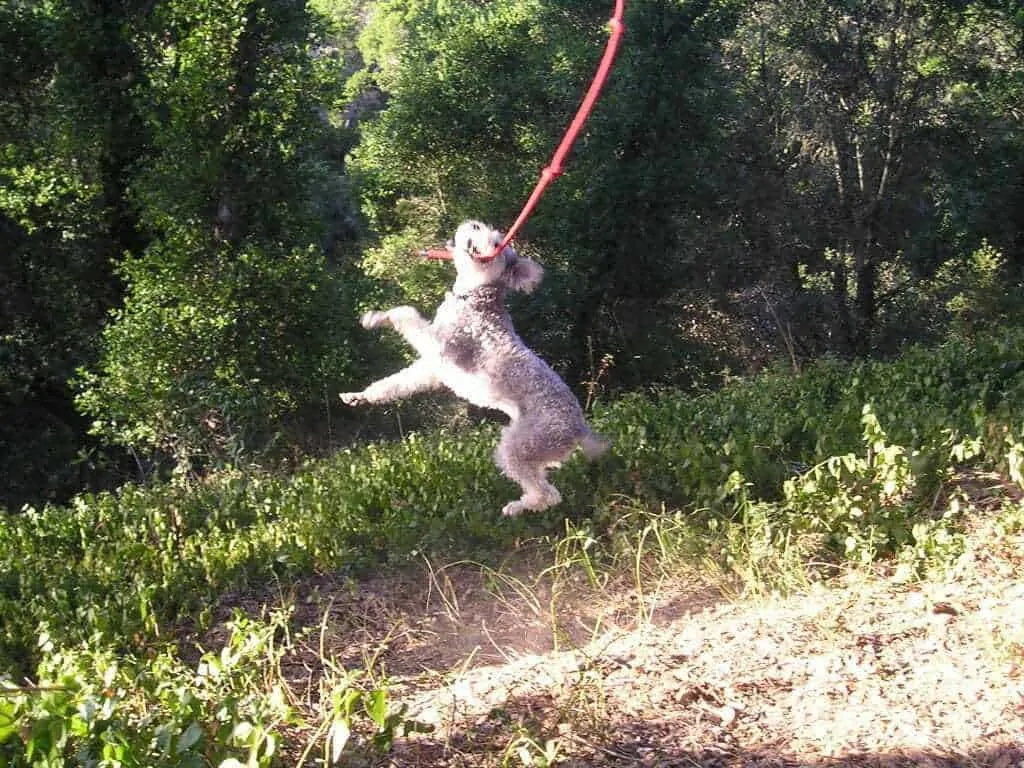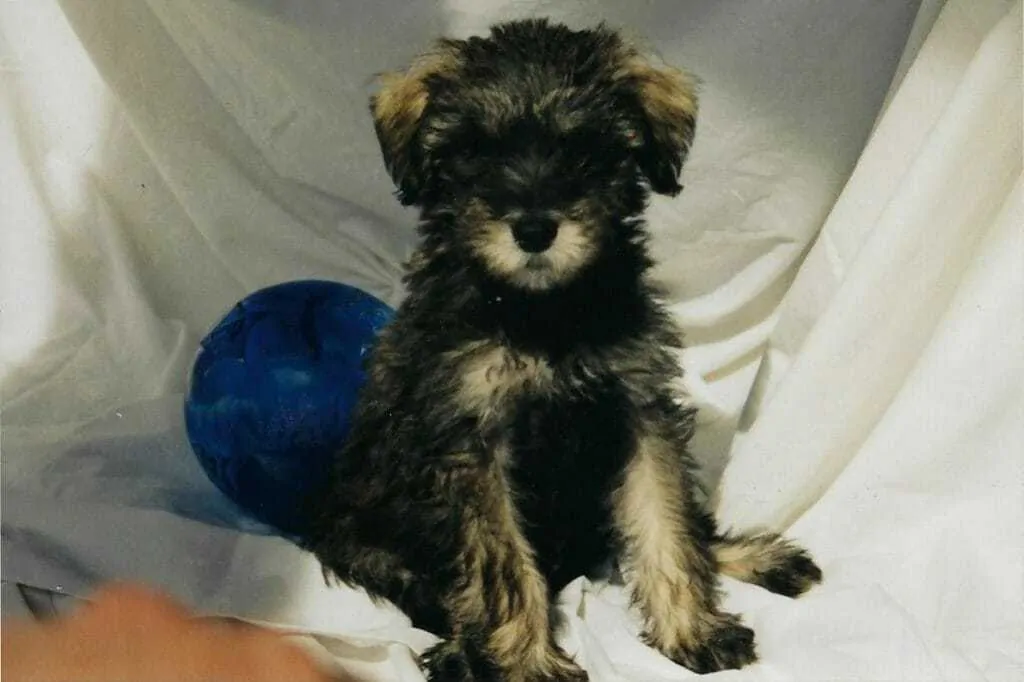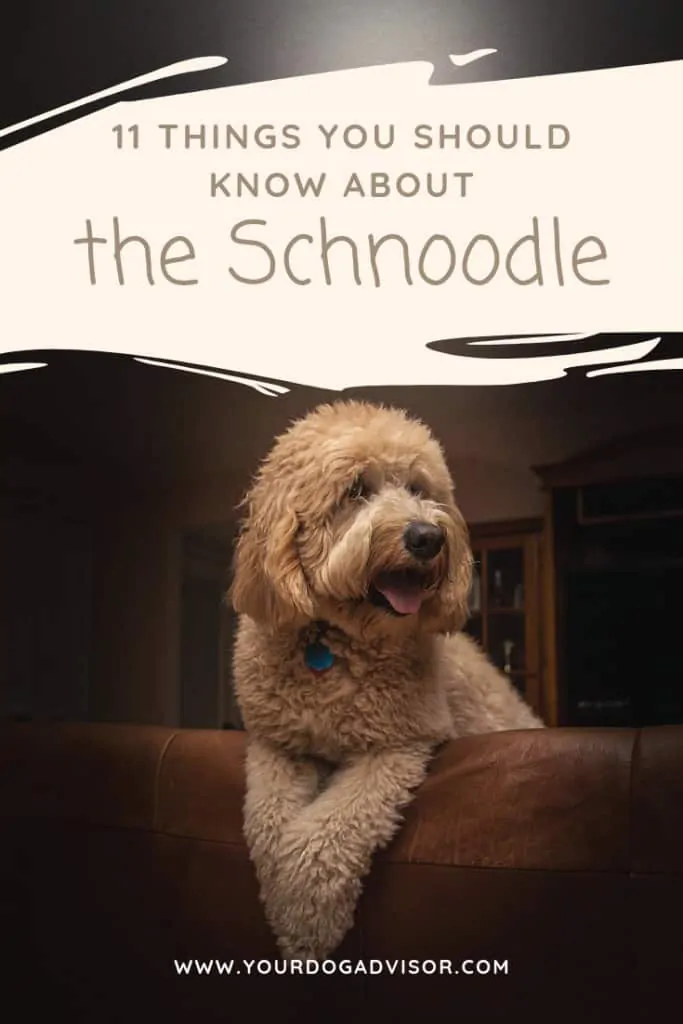Friendly, smart, and loyal, the Schnoodle is a cross-breed of the Poodle and the Schnauzer. This “designer breed” first showed up onto the scene in the 1980s and has made a home for itself in the hearts of families ever since.
I had the joy of having a Schnoodle in my life for 16 years! Dusty was the perfect dog for a family with energetic kids, a mom with allergies, and a dad who liked having a nearby buddy.
Maybe the Schnoodle is a right match for your family as well! Here are a few things you should know.
Schnoodles are happy, active, and loyal dogs that enjoy adventures – as long as they’re with you! Here is a Schnoodle enjoying a fun beach day.
Contents
1. Schnauzer + Poodle = Schnoodle
Ten week old Schnoodle puppy with the typical Poodle-influenced fluffy coat, but Schnauzer-influenced expressive eyebrows.
A Schnoodle is a combination of a Schnauzer and a Poodle. Both of these dogs are among the most popular dog breeds, so it’s no surprise that someone would combine them for the best of both worlds.
The Schnauzer is energetic, loyal, and a little feisty. The Poodle is an intelligent dog with a reputation for being aristocratic – but who can also be a great athletic and versatile family dog. Combine the two, and you have a dog that is smart, energetic, and loyal! Not to mention, super cute.
2. The Schnoodle is a Crossbreed
The Schnoodle is a crossbreed, or a “first generation dog.” That means that a Schnoodle has a Poodle and a Schnauzer for a parent, instead of two Schnoodles.
Because it’s a crossbreed, there is less consistency within the breed. With one litter, you may get more of the personality traits of the Schnauzer and more of the physical traits of the Poodle – with the next litter, it may flip-flop! Schnoodle traits could even vary puppy to puppy.
A Schnoodle’s fur may be more curly like a Poodle, or more wiry like a Schnauzer. They may be extremely loyal like a Schnauzer, or more independent like a Poodle. There can be a lot of variety with Schnoodles, but because you’re combining two great dogs, the whole spectrum makes for a great addition to your family.
3. Schnoodles are (Mostly) Hypoallergenic
Schnoodles’ hair-like coats and low dander make them a great candidate for anyone who typically struggles with dog allergies.
Schnoodles have hair-like coats that have very little shedding and low dander. Like most Poodle crossbreeds, they have a reputation for being hypoallergenic.
It’s worth mentioning, however, that some people are still allergic to “hypoallergenic” dogs, and if you are considering getting a dog but have allergies, it’s worth spending a bit of time around a that breed before you make the decision.
Overall, most people that have standard dog allergies are able to tolerate cohabiting with a Schnoodle!
4. Schnoodles Come In Lots of Sizes!
Schnauzers and Poodles come in a variety of sizes – and so does the Schnoodle! The Schnoodle can range from 6 lbs – 75 lbs, depending on which sizes of Poodles and Schnauzers your mix. The nomenclature of sizes isn’t consistent can be a little confusing.
Poodles come in Toy (small), Miniature (medium), and Standard (large). Schnauzers come in Miniature (small), Standard (medium), and Giant (large).
The smallest size Schnoodle is about the size of a Chihuahua and is a mix of a Toy Poodle and a Miniature Schnauzer. This perma-pup will range from 6 to 10 pounds, and is a great size if you often travel and like to bring your dog on the plane with you.
The medium size Schnoodle mixes a Miniature Poodle and a Standard Schnauzer. This mid-size dog is typically about 12-20 lbs, and can be a great dog for a family!
The next size up is a large Schnoodle, which crosses a Standard Poodle and a Giant Schnauzer, ranging anywhere from 20-75 lbs. If you go this route, be prepared for a big and energetic dog!
There is no regulation and little consistency within sizes. For example, a breeder could mix a Miniature (medium) Poodle with a Giant (large) Schnauzer for an in-between size, and many breeders do just that.
The variations in sizes means that if you have your heart set on the breed, you can certainly find one that fits your life and living space! Just make sure to ask what sizes the parents are!
5. Schnoodles are Great Companion Dogs
Schnoodle cuddling with an owner. Because of the loyalty trait passed down from the Schnauzer, a Schnoodle’s favorite place is wherever you are!
Schnoodles want to be part of your family. They, like the Schnauzer, are very loyal and will possibly follow you around from room to room in order to stay near you. No matter what you are doing, they want to be there with you!
Because Schnoodles value the family so much, they must be kept in the house with the rest of the family members. This is not a “lone wolf” outdoor dog that is happy to have the sprawling property be his primary domain – he wants to be with you!
This breed gets along well with the family and will become a devoted family member. If they’ve adopted a lot of the Schnauzer traits, in addition to being loyal, they’ll also be protective. Since neither the Poodle nor the Schnauzer are attack dogs, the Schnoodle’s demonstration of protection is more vocal than aggressive: all bark, and no bite. They’ll love you, and they’ll let potential intruders (or visiting friends) know it!
6. Schoodles Require Grooming
Here’s a Schnoodle whose coat has grown long and fluffy. As with a Poodle, there are lots of options for how you choose to groom your dog. You can let it grow long and fluffy, or keep it short and soft. The choice is up to you!
Because Schnoodles have longer coats that will grow and mat if not attended to, they require maintenance. They should be brushed at home a few times a week and brought to the groomers at least every 12 weeks.
Like with the Poodle, you have a lot of options for how you want to groom your dog. You can cut the fur short, let it grow long and fluffy, or anything in-between! If you live in a warm place, consider cutting it shorter in the summer so your doggie doesn’t risk overheating. Otherwise, the choice is up to you!
One thing to note is that Schnoodles do have a possibility of getting ear infections if their ear hair is not kept under control. When you bring your pup to the groomers, make sure to ask specifically for them to attend to the hair in the ears to help prevent infection.
7. The Lifespan of a Schnoodle Varies Greatly
The size of the dog can greatly influence the lifespan of the dog. Small dogs tend to have longer life spans than bigger ones. Because there is such a large and unregulated variety in sizes of Schnoodles, their lifespans vary greatly.
The average lifespan of a Miniature (small) Schnoodle is about 10-18 years. The Standard (medium) size is about 10-16 years, and the Giant (large) variety is about 10-15 years. However, this could vary depending on the sizes of the parents, and the general health and lifestyle of the dog.
8. Schnoodles are Active!
A Schnoodle enjoying a long walk on the beach! These are an active breed, so make sure they get 30-60 minutes of activity everyday in order to keep them happy and healthy.
The Schnauzer was originally bred to be an all-around farm dog, actively helping out on the family farm. The Poodle was originally used as a retriever dog, retrieving birds for their hunters. Combine these two active dogs, and it’s no surprise that the Schnoodle is active too!
The Schnoodle loves to run and jump. His natural physical aptitude with its high intelligence makes the Schnoodle and great candidate for agility courses!
Regardless of if you’re working toward a goal, or just playing in the backyard, you should make sure that your Schnoodle gets 30-60 minutes of exercise each day.
Because there is such a variation in sizes for the Schnoodle, though, take into consideration that your dog may need more or less exercise. An hour of activity is a lot for a six pound dog!
9. The Sky is the Limit with Training
Your Schnoodle will certainly be smart, and he will hopefully be eager to please, so the sky is the limit with what you can train him to do!
In addition to training your pup to sit, stay, and come, this is a dog that you can train to fetch your slippers, scoot over a little bit, or find the kibble under one of three cups.
Your creativity and patience are the only limiting factors – this dog will be able to keep up!
Their ability to learn has benefits beyond simply learning fun tricks! Because of their loyal, devoted, and intelligent nature, Schnoodles have a reputation for making great therapy dogs! They can quickly learn what is requested of them, and once they have a connection with someone, they are friends for life.
10. Schnoodles Live to have FUN!
Full grown Schnoodle energetically playing on a rope swing. Schnoodles live to have fun and will join you in whatever activity you are doing!
Think of the kid you went to highschool with that always wanted to play, could rarely sit still, and still got good grades on the test. Yep, that’s your Schnoodle! This dog is smart, but at his core, he lives to have a good time.
While other lower energy dogs might be happy with one or two walks per day and lots of naps in between, this dog will keep wanting to play long after the walk is finished!
While your Schnoodle will be happy to join you in whatever game you’re playing, a fun trick for high energy dogs is to play games based on what they’re naturally adept at. Terrier-like breeds like the Schnauzer love to dig, so you could designate an area of your yard to digging and bury a few toys or treats for your pup to dig up. Poodles are retrievers, so why not play a game of catch? To get the energy out faster, consider a chuckit ball launcher or something similar so that your arm doesn’t wear out before their legs.
The more fun (and active!) you make your dog’s life, the less likely you are to have behavioral problems at home. A tired dog is a happy (and obedient!) dog.
11. The Schnoodle is Called the “Teddy Bear Dog”
The Schnoodle has a reputation for being the “Teddy Bear Dog” because of cute the puppies are!
For all of its great personality and ability qualities, there is also absolutely no denying that the Schnoodle is stinking cute. The Schnoodle has earned the nickname of “the teddy bear dog”, and for good reason. The puppies and even the full-grown versions of the smallest size look like little stuffed animals. The expressive Schnauzer face with typically curly Poodle coat makes for an adorable combination that you’ll need to remind yourself is real!
As with all cute little puppies, don’t let the sweet exterior lure you into a commitment that you’re not ready for. This teddy bear pup will grow into a full-grown, energetic dog requiring your time, love, and attention.
If you’re up to the task of welcoming a four legged companion into your family, and you enjoy a bit of outside play, the Schnoodle could be a great option for you!
This sweet, loyal, and intelligent breed would be excited to join your loving family, and you will be rewarded for your choice with a fun-loving adventure buddy who will always be up to play – as long as it’s with you!
